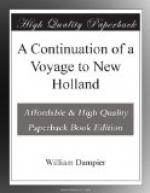About 1 in the afternoon we weighed and stood to the eastward, between the main and King William’s Island; leaving the island on our larboard side and sounding till we were past the island; and then we had no ground. Here we found the flood setting east by north, and the ebb west by south. There were shoals and small islands between us and the main, which caused the tide to set very inconstantly, and make many whirlings in the water; yet we did not find the tide to set strong any way, nor the water to rise much.
Plying on the coast of new guinea.
On the 9th, being to the eastward of King William’s Island, we plied all day between the main and other islands, having easterly winds and fair weather till 7 the next morning. Then we had very hard rain till 8 and saw many shoals of fish. We lay becalmed off a pretty deep bay on New Guinea, about 12 or 14 leagues wide and 7 or 8 leagues deep, having low land near its bottom, but high land without. The eastermost part of New Guinea seen bore east by south, distant 12 leagues: Cape Mabo west-south-west half south, distant 7 leagues.
At 1 in the afternoon it began to rain and continued till 6 in the evening; so that, having but little wind and most calms, we lay still off the forementioned bay, having King William’s Island still in sight, though distant by judgment 15 or 16 leagues west. We saw many shoals of small fish, some sharks, and 7 or 8 dolphins; but caught none. In the afternoon, being about 4 leagues from the shore, we saw an opening in the land which seemed to afford good harbour: in the evening we saw a large fire there; and I intended to go in (if winds and weather would permit) to get some acquaintance with the natives.
Since the 4th instant that we passed Cape Mabo to the 12th we had small easterly winds and calms, so that we anchored several times; where I made my men cut wood, that we might have a good stock when a westerly wind should present; and so we plied to the eastward, as winds and currents would permit; having not got in all above 30 leagues to the eastward of Cape Mabo. But on the 12th, at 4 in the afternoon, a small gale sprang up at north-east by north with rain: at 5 it shuffled about to north-west, from thence to the south-west, and continued between those 2 points a pretty brisk gale; so that we made sail and steered away north-east, till the 13th in the morning, to get about the Cape of Good Hope. When it was day we steered north-east half east, then north-east by east till 7 o’clock; and being then 7 or 8 leagues off shore we steered away east; the shore trending east by south. We had very much rain all night, so that we could not carry much sail; yet we had a very steady gale. At 8 this morning the weather cleared up and the wind decreased to a fine top-gallant gale, and settled at west by south. We had more rain these 3 days past than all the voyage in so short time. We were now about 6 leagues from the land of New Guinea, which appeared very high; and we saw 2 headlands, about 20 leagues asunder; the one to the east, and the other to the west, which last is called the Cape of Good Hope. We found variation east 4 degrees.




